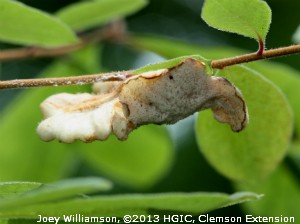What’s that thing growing on my azalea?
go.ncsu.edu/readext?415863
en Español / em Português
El inglés es el idioma de control de esta página. En la medida en que haya algún conflicto entre la traducción al inglés y la traducción, el inglés prevalece.
Al hacer clic en el enlace de traducción se activa un servicio de traducción gratuito para convertir la página al español. Al igual que con cualquier traducción por Internet, la conversión no es sensible al contexto y puede que no traduzca el texto en su significado original. NC State Extension no garantiza la exactitud del texto traducido. Por favor, tenga en cuenta que algunas aplicaciones y/o servicios pueden no funcionar como se espera cuando se traducen.
Português
Inglês é o idioma de controle desta página. Na medida que haja algum conflito entre o texto original em Inglês e a tradução, o Inglês prevalece.
Ao clicar no link de tradução, um serviço gratuito de tradução será ativado para converter a página para o Português. Como em qualquer tradução pela internet, a conversão não é sensivel ao contexto e pode não ocorrer a tradução para o significado orginal. O serviço de Extensão da Carolina do Norte (NC State Extension) não garante a exatidão do texto traduzido. Por favor, observe que algumas funções ou serviços podem não funcionar como esperado após a tradução.
English
English is the controlling language of this page. To the extent there is any conflict between the English text and the translation, English controls.
Clicking on the translation link activates a free translation service to convert the page to Spanish. As with any Internet translation, the conversion is not context-sensitive and may not translate the text to its original meaning. NC State Extension does not guarantee the accuracy of the translated text. Please note that some applications and/or services may not function as expected when translated.
Collapse ▲ This spring’s cool, wet weather has favored the growth of exobadium leaf galls. Exobasidium is a fungus that is very common in early spring on azaleas (Exobasidium vaccinii) and camellia (Exobasidium camelliae). The fungus infects the new shoots and leaves causing them to become enlarged, thickened, and distorted. The affected tissue turns from light green to nearly white or pink. Later, the galls mature and either rupture to release spores (camellia) or become covered in a powdery white substance before turning brown and hard (azalea).
This spring’s cool, wet weather has favored the growth of exobadium leaf galls. Exobasidium is a fungus that is very common in early spring on azaleas (Exobasidium vaccinii) and camellia (Exobasidium camelliae). The fungus infects the new shoots and leaves causing them to become enlarged, thickened, and distorted. The affected tissue turns from light green to nearly white or pink. Later, the galls mature and either rupture to release spores (camellia) or become covered in a powdery white substance before turning brown and hard (azalea).
Exobasidium leaf gall rarely does enough damage to warrant chemical control. Instead, simply remove and destroy any young galls before they mature and release their spores. This will help prevent the disease from spreading next season. Rake up and remove fallen leaves and avoid wetting the leaves when watering plants.



